Mip 300 exam 4 Study guides, Class notes & Summaries
Looking for the best study guides, study notes and summaries about Mip 300 exam 4? On this page you'll find 52 study documents about Mip 300 exam 4.
Page 4 out of 52 results
Sort by
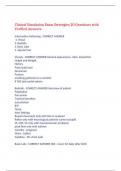
-
Clinical Simulation Exam Strategies 20 Questions with Verified Answers,100% CORRECT
- Exam (elaborations) • 4 pages • 2023
-
- $10.49
- + learn more
Clinical Simulation Exam Strategies 20 Questions with Verified Answers Information Gathering - CORRECT ANSWER 1. Visual 2. Bedside 3. Basic Labs 4. Special Test Visuals - CORRECT ANSWER General appearance, color, inspection Height and Weight History Pulse (pick last) Sensorium Posture anything gathered on a monitor If CHF pick pedal edema Bedside - CORRECT ANSWER Interview of patient Palpitation Percussion Tracheal devation auscultation B/P Temp Vent Settings Bowel M...
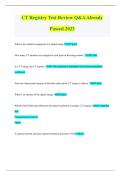
-
CT Registry Test Review Q&A Already Passed 2023
- Exam (elaborations) • 89 pages • 2023
-
- $12.99
- + learn more
CT Registry Test Review Q&A Already Passed 2023 What is the smallest component of a digital image *ANS* pixel How many CT numbers are assigned to each pixel in the image matrix? *ANS* One In a CT image, the CT number *ANS* Of a material is dependent on its linear attenuation coefficient Each two-dimensional square of data that make up the CT image is called a *ANS* pixel What is an element of the digital image *ANS* pixel Which of the following influences the spatial resolution...
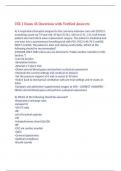
-
CSE 1 Exam 45 Questions with Verified Answers,100% CORRECT
- Exam (elaborations) • 27 pages • 2023
-
- $10.99
- + learn more
CSE 1 Exam 45 Questions with Verified Answers A) A respiratory therapist assigned to the coronary intensive care unit (CICU) is evaluating a post-op 74-year-old, 69 kg (152 lb.), 160 cm (5 ft., 3 in.) tall female patient who had mitral valve replacement surgery. The patient is intubated and one hour into a spontaneous breathing trial with PSV, FIO2 0.40, PS 5 cmH20, PEEP 5 cmH20. The patient is alert and resting comfortably. Which of the following should be recommended? (CHOOSE ONLY ONE unle...

-
ACCS Respiratory Exam Rated 100% Correct Answers 2024
- Exam (elaborations) • 60 pages • 2024
-
- $16.49
- + learn more
ACCS Respiratory Exam Rated 100% Correct Answers 2024 Normal Urine Output - Answer 40 mL/hr (approx. 1 Liter/day) Decreased CVP (<2 mmHg) - Answer Hypovolemia Increased CVP (>6 mmHg) - Answer Hypervolemia Glasgow Coma Scale (GCS) - Answer Eye-opening response Spontaneous opening- 4 To verbal stimuli- 3 To pain- 2 None- 1 Most appropriate verbal response Oriented- 5 Confused- 4 Inappropriate words- 3 Incoherent- 2 None- 1 Most intergrated motor response (arm) Obeys commands...
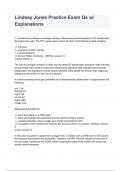
-
Lindsey Jones Practice Exam Qs w/ Explanations
- Exam (elaborations) • 43 pages • 2024
-
- $17.99
- + learn more
Lindsey Jones Practice Exam Qs w/ Explanations 1. A patient has undergone overnight oximetry. Data shows several episodes of O2 desaturation throughout the night. The RTT would expect orders for which of the following kinds of testing: a. V/Q scan b. pulmonary function testing c. polysomnography d. 24-hour Holter monitoring - ANSYour answer: C Correct answer: C The use of overnight oximetery is often used to detect O2 desaturation during the night that may be associated with...
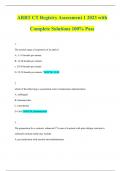
-
ARRT CT Registry Assessment 1 2023 with Complete Solutions 100% Pass
- Exam (elaborations) • 63 pages • 2023
-
- $10.99
- + learn more
ARRT CT Registry Assessment 1 2023 with Complete Solutions 100% Pass 1. The normal range of respiration of an adult is A. 5- 10 breaths per minute B. 12-20 breaths per minute c. 20-30 breaths per minute D. 35-50 breaths per minute *ANS* B. 12-20 2 which of the following is a parenteral route of medication administration A. sublingual B. Intramuscular C. transdermal D. Oral *ANS* B. Intramuscular 3 The preperation for a contrast- enhanced CT exam of a patient with prior aller...
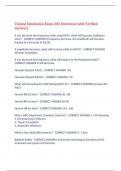
-
Clinical Simulation Exam 285 Questions with Verified Answers,100% CORRECT
- Exam (elaborations) • 22 pages • 2023
-
- $12.49
- + learn more
Clinical Simulation Exam 285 Questions with Verified Answers If you decrease the frequency while using HFOV, what will increase, leading to what? - CORRECT ANSWER If frequency decrease, the amplitude will increase, leading to a decrease in PaCO2. If amplitude increases, what will increase while on HFOV? - CORRECT ANSWER Alveolar Ventilation If you decrease the frequency, what will happen to the Respiratory Rate? - CORRECT ANSWER It will decrease Neonate Desired PaO2? - CORRECT ANSWER...

-
TMC EXAM 4, Predictor Questions and answers, 100% Accurate. Verified.
- Exam (elaborations) • 67 pages • 2023
- Available in package deal
-
- $12.49
- + learn more
TMC EXAM 4, Predictor Questions and answers, 100% Accurate. Verified. Which of the following equipment is most helpful at measuring FRC in a patient who has significant non-ventilated lung spaces? A. nitrogen analyzer for a nitrogen washout test B. helium analyzer for a helium dilution test C. plethysmograph D. peak flow meter - -The correct answer is : C Explanation : You can determine FRC in three different ways - body box, nitrogen washout, or helium dilution. If someone h...
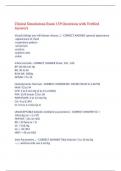
-
Clinical Simulations Exam 159 Questions with Verified Answers,100% CORRECT
- Exam (elaborations) • 20 pages • 2023
-
- $11.49
- + learn more
Clinical Simulations Exam 159 Questions with Verified Answers Visuals (things you will always choose...) - CORRECT ANSWER -general appearance -appearance of chest -respiratory pattern -sensorium -posture -patient color -pulse Infant normals - CORRECT ANSWER Pulse: 110 - 160 BP: 60/40 mm Hg RR: 30 to 60 Birth Wt: 3000g APGAR: 7 to 10 Hemodynamic Normals - CORRECT ANSWER BP: 120/80 (90/60 to 140/90) MAP: 93 to 94 CVP: 2 to 6 mm Hg (4 to 12 cmH2O) PAP: 25/8 (mean 13 to 14) PW...

-
TMC EXAM 4 question and answer 100% correct
- Exam (elaborations) • 50 pages • 2023
- Available in package deal
-
- $15.49
- + learn more
TMC EXAM 4 question and answer 100% correctWhich of the following equipment is most helpful at measuring FRC in a patient who has significant non-ventilated lung spaces? A. nitrogen analyzer for a nitrogen washout test B. helium analyzer for a helium dilution test C. plethysmograph D. peak flow meter The correct answer is : C Explanation : You can determine FRC in three different ways - body box, nitrogen washout, or helium dilution. If someone has non-ventilated lung space, nitrogen w...

Do you wonder why so many students wear nice clothes, have money to spare and enjoy tons of free time? Well, they sell on Stuvia! Imagine your study notes being downloaded a dozen times for $15 each. Every. Single. Day. Discover all about earning on Stuvia


